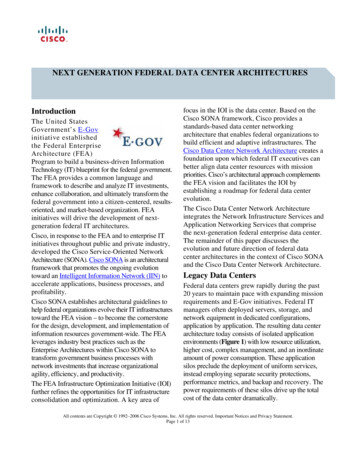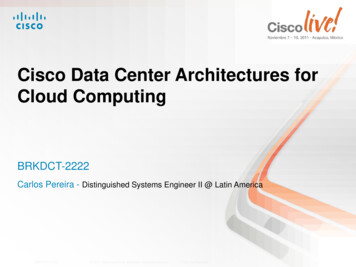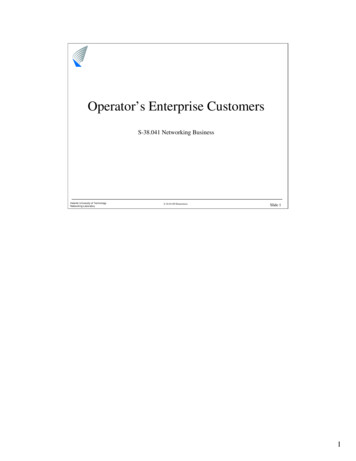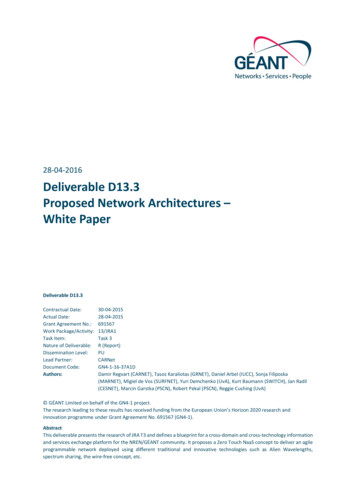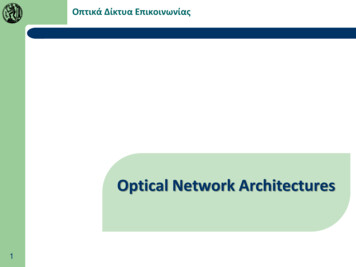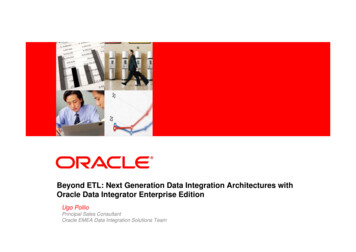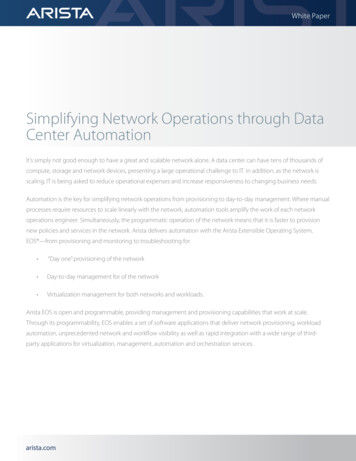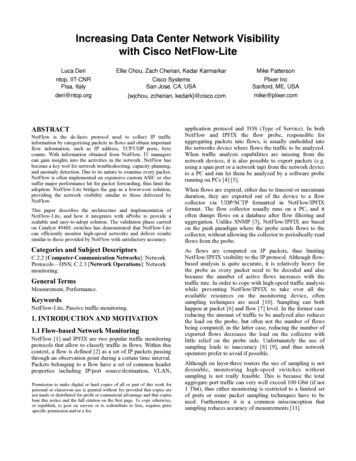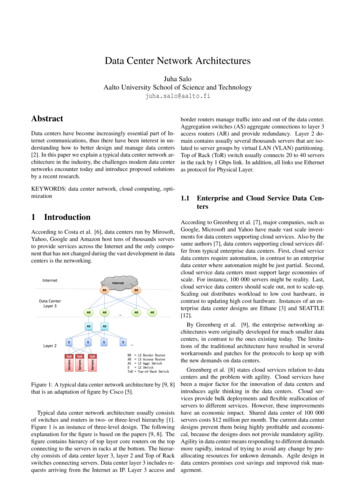
Transcription
Data Center Network ArchitecturesJuha SaloAalto University School of Science and Technologyjuha.salo@aalto.fiAbstractData centers have become increasingly essential part of Internet communications, thus there have been interest in understanding how to better design and manage data centers[2]. In this paper we explain a typical data center network architecture in the industry, the challenges modern data centernetworks encounter today and introduce proposed solutionsby a recent research.KEYWORDS: data center network, cloud computing, optimization1IntroductionAccording to Costa et al. [6], data centers run by Mirosoft,Yahoo, Google and Amazon host tens of thousands serversto provide services across the Internet and the only component that has not changed during the vast development in datacenters is the networking.InternetInternetBRBRData CenterLayer 3ToRARASASSSToR ServersToRServersSServersLayer 2ARAR SAR BRARASSToR L3 Border RouterL3 Access RouterL2 Aggr SwitchL2 SwitchTop-of-Rack SwitchFigure 1: A typical data center network architecture by [9, 8]that is an adaptation of figure by Cisco [5].Typical data center network architecture usually consistsof switches and routers in two- or three-level hierarchy [1].Figure 1 is an instance of three-level design. The followingexplanation for the figure is based on the papers [9, 8]. Thefigure contains hierarcy of top layer core routers on the topconnecting to the servers in racks at the bottom. The hierarchy consists of data center layer 3, layer 2 and Top of Rackswitches connecting servers. Data center layer 3 includes requests arriving from the Internet as IP. Layer 3 access andborder routers manage traffic into and out of the data center.Aggregation switches (AS) aggregate connections to layer 3access routers (AR) and provide redundancy. Layer 2 domain contains usually several thousands servers that are isolated to server groups by virtual LAN (VLAN) partitioning.Top of Rack (ToR) switch usually connects 20 to 40 serversin the rack by 1 Gbps link. In addition, all links use Ethernetas protocol for Physical Layer.1.1Enterprise and Cloud Service Data CentersAccording to Greenberg et al. [7], major companies, such asGoogle, Microsoft and Yahoo have made vast scale investments for data centers supporting cloud services. Also by thesame authors [7], data centers supporting cloud services differ from typical enterprise data centers. First, cloud servicedata centers require automation, in contrast to an enterprisedata center where automation might be just partial. Second,cloud service data centers must support large economies ofscale. For instance, 100 000 servers might be reality. Last,cloud service data centers should scale out, not to scale-up.Scaling out distributes workload to low cost hardware, incontrast to updating high cost hardware. Instances of an enterprise data center designs are Ethane [3] and SEATTLE[12].By Greenberg et al. [9], the enterprise networking architectures were originally developed for much smaller datacenters, in contrast to the ones existing today. The limitations of the traditional architecture have resulted in severalworkarounds and patches for the protocols to keep up withthe new demands on data centers.Greenberg et al. [8] states cloud services relation to datacenters and the problem with agility. Cloud services havebeen a major factor for the innovation of data centers andintroduces agile thinking in the data centers. Cloud services provide bulk deployments and flexible reallocation ofservers to different services. However, these improvementshave an economic impact. Shared data center of 100 000servers costs 12 million per month. The current data centerdesigns prevent them being highly profitable and economical, because the designs does not provide mandatory agility.Agility in data center means responding to different demandsmore rapidly, instead of trying to avoid any change by preallocating resources for unkown demands. Agile design indata centers promises cost savings and improved risk management.
TKK T-110.5190 Seminar on Internetworking1.2Cost structureIn [7] Greenberg et al. presents data about the cost structurein a data center. Networking in data centers consumes 15%of total costs, as shown in table 1. However, networking hasa more widespread impact on the whole system. Innovatingthe networking is the key to reduce the total entsServersInfrastructurePower drawNetworkCPU, memory, storagePower distribution, coolingElectrical utility costsLinks, transit, equipment2010-05-05, updated 2012-07-05According to Guo et al. [10], a more attractive performanceto-price ratio can be achieved by using commodity hardware,because the per-port cost is cheaper for the commodity hardware than with the more technically advanced onesCabling complexity could be a practical barrier for scalability, for instance in modular data center (MDC) designthe long cables between the containers cause an issue as thenumber of containers increase [14].Physical constraints [13], such as high density configurations in racks might lead at room level to very high powerdensities. Also, an efficient cooling solution is important fordata center reliability and uptime. In addition, air handlingsystems and rack layouts affect the data center energy consumption.Table 1: Typical data center costs [7].2.2By [7], the greatest portion of total costs belong to theservers. To allow efficient use of the hardware, a high levelof utilization, the data centers should provide a method todynamically grow the number of servers and allow focusingresources on optimal locations. Now the fragmentation ofresources prevents the server utilization.According to Greenberg et al. [7], reducing infrastructurecosts might depend on allowing scale out model of low costservers. Scaling out in a data center might mean shiftingthe responsibility of expensive qualities of servers, such asfailure rate from a single server to the whole system. Byallowing the network architecture to scale out, the low failurerate is ensured by having multiple cheap servers, rather thana few expensive ones.By [7], power related costs are similar to the network’s.IT devices consume 59% of each watt delivered, 8% to distribution losses and 33% for cooling. Cooling related costscould be reduced by allowing the data centers to run hotter,thus maybe requiring the network to be more resilient andmesh-like.Also Greenberg et al. [7] note that significant fraction ofnetwork related costs goes to networking equipment. Otherportions of the total costs of the network relate to wide areanetworking, including traffic to end users, traffic betweendata centers and regional facilities. Reducing the networkcosts focuses on optimizing the traffic and data center placement.In this paper we focus only on the problems and solutionsof the data center network architectures. Section 2 of thispaper covers the main problems of network architectures.Next, section 3 evaluates different proposed solutions. Last,in conclusion we summarize the the main topics.Resource oversubscription and fragmentationBy [9, 8] oversubscription ratio increases rapidly when moving up in the typical network architecture hierarchy, as seenin Figure 1. By the same authors, oversubscription ratiomeans the ratio of subscriptions to what is available. Forinstance, 1:20 oversubscription ratio could be 20 different 1Gbps servers subscribed to one 1Gbps router. Ratio of 1:1means that the subscriber can communicate with full bandwidth. In a typical network architecture the oversubscription ratio can be 1:240 for the paths crossing the top layer.Limited server-to-server capacity limits the data center performance and fragments the server pool, because unused resources can not be assigned where they are needed. To avoidthis problem all applications should be placed carefully andtaking the impact of the traffic in concern. However, in practice this a real challenge.Limited server-to-server capacity [9, 8] leads to designersclustering the servers near each others in the hierarchy, because the distance in the hierarchy affects the performanceand cost of the communication. In addition, access routersassign IPs topologically for the layer 2, thus placing servicesoutside layer 2-domain requires additional configuration. Intodays data centers the additional configuration is avoidedby reserving resources, thus wasting resources. Even reservation can not predict if a service needs more than there is reserved, resulting in allocating resources from other services.As a consequence of the dependencies resources are fragmented and isolated.2.3Reliability, utilization and fault toleranceData centers suffer from poor reliability and utilization [8]. Ifsome component of the data center fails, there must be somemethod to keep the data center functioning. Usually counterpart elements exists, so when an access router fails for in2 Problems with network architec- stance the counterpart handles the load. However, this leadsto elements use only 50% of maximum capacity. Multipleturespaths are not effectively used in current data center networkarchitectures. Two paths at most is the limit in conventional2.1 Scalability and physical constraintsnetwork architectures.The data center scaling out means addition of componentsTechniques, such as Equal Cost Multipath Routingthat are cheap, whereas in scaling up more expensive compo- (ECMP) can be used to utilize multiple paths [11]. Accordnents are upgraded and replaced to keep up with demand [9]. ing to Al-Fares et al. [1], ECMP is currently supported by
TKK T-110.5190 Seminar on Internetworkingswitches, however several challenges are yet to be resolved,such as routing tables grows multiplicatively to number ofpaths used, thus presumably increasing lookup latency andcost.According to [2], links in the core of data centers compared to the average are more utilized and links on the edgeare affected by higher losses on average. This research isbased on the SNMP data of 19 different data centers.Due to space and operational constraints in some designs,fault tolerance and graceful performance degradation is considered extremely important [10]. Graceful performancedegradation could be challenging to ensure in a typical network architectures, for instance in one incident a core switchfailure lead to performance issues with ten million users forseveral hours [8].2.4CostAccording to Al-Fares et al. [1], cost is a major factor thataffects the data center network architecture related decisions.Also by the same authors, one method to reduce costs is tooversubscribe data center network elements. However, oversubscription leads to problems as stated earlier. Next, we areintroducing the results of a study [1] how maintaining 1:1subscriptioin ratio relates to cost by having different type ofnetwork design. Table 2 represent the maximum cluster sizesupported by the most advanced 10 GigE and commodityGigE switches during a specific year. The table is divided intwo different topologies, as explained in [1]: Hierarchical design contains advanced 10 GigEswitches on layer 3 and as aggregation switched onlayer 2. Commodity GigE switches are used on theedge in the hierarchical design. Until recently, the portdensity of advanced switches has limited the maximumcluster size. Also, aggregation switches did not have10 GigE uplinks until recent new products. The pricedifference compared to Fat-tree design is significant.2010-05-05, updated 2012-07-05Hierarchical designYear 10 GigE Hosts Cost/GigE2002 28-port 4,480 25.3K2004 32-port 7,680 4.4K2006 64-port 10,240 2.1K2008 128-port 20,480 ost/GigE5,488 4.5K27,648 1.6K27,648 1.2K27,648 0.3KTable 2: The largest cluster sizes supported by switched withan oversubscription ratio 1:1 during 2002 - 2008 [1].words, TCP does not suit for a special data center environment with low latencies and high bandwidths, thus limits thefull use of all capacity.By [4], in Incast a receiver requests data from multiplesenders. Upon receiving the request the senders start transmitting data to the original receiver concurrently with theother senders. However, in the middle of the connectionfrom sender to receiver is a bottleneck link resulting a collapse in the througput the receiver receives the data. Theresulted network congestion affects all the senders using thesame bottleneck link.According to Chen et al. [4], upgrading and increasingthe buffer sizes of swithes and routers delays congestion, butin high latency and banwidth data center environment thebuffers can still fill up in a short period of time. In addition,large buffer switches and routers are expensive.33.1Proposed network architecturesFat-treeAl-Fares et al. [1] introduces Fat-tree, as seen in Figure 2,that enables the use of inexpensive commodity network elements for the architecture. All switching elements in thenetwork are indentical. Also, there are always some paths tothe end hosts that will use the full bandwidth. Further, the Fat-tree is a topology that supports building a large- cost of Fat-tree network is less than traditional one as seen inscale commodity network from commodity switches, in table 2.contrast to building a traditional hierarchical networkusing expensive advanced switches. In this table, fattree is just an example of such commodity networks.Fat-tree includes commodity GigE switches on all layers in the network architecture. It is worth noting thecost difference between hierarchical and fat-tree design.The total costs of Fat-tree design during the years hasreduced rapidly, because of the decreasing price trendPod 0Pod 2Pod 3Pod 1LinkServerSwitchCore switchof the commodity hardware.Figure 2: Fat-tree design [1].2.5IncastChen et al. [4] researched TCP Throughput Collapse, alsoknown as Incast, which causes under-utilization of link capacity. By [4], a vast majority of data centers use TCP for
Figure 1: A typical data center network architecture by [9, 8] that is an adaptation of figure by Cisco [5]. Typical data center network architecture usually consists of switches and routers in two- or three-level hierarchy [1]. Figure 1 is an instance of three-level design. The following explanation for the figure is based on the papers [9, 8]. TheFile Size: 538KBPage Count: 6
